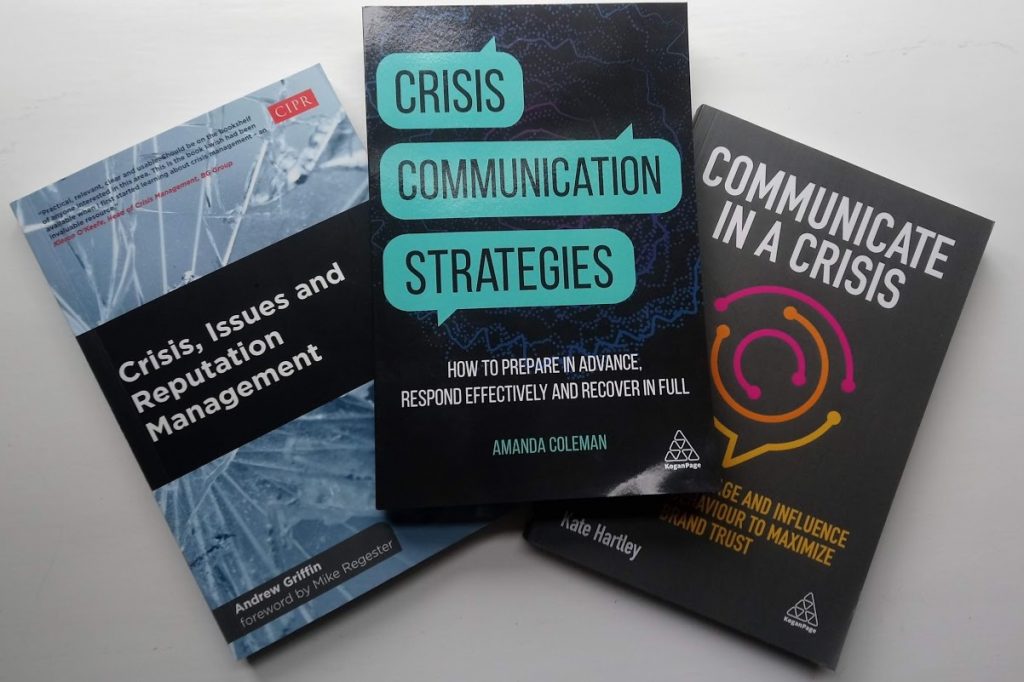Review: Crisis Communication Strategies

About the author
Richard Bailey Hon FCIPR is editor of PR Academy's PR Place Insights. He teaches and assesses undergraduate, postgraduate and professional students.

Crisis Communication Strategies: How to prepare in advance, respond effectively and recover in full
By Amanda Coleman
Kogan Page, 2020, 201 pages
You can’t have missed the big lesson from the lockdown and economic slowdown for our industry: promotional activity associated with marketing comms seems less important, while the less visible work of corporate comms has come to the fore. We’ve also come to value the work of the public services. Above all, we’ve all switched into crisis responsiveness.
So this is a good time to learn some lessons from the experts. I reviewed two recent practitioner contributions to the crisis comms literature here; now there’s another from the former head of corporate communications for Greater Manchester Police who was in post at the time of the Manchester Arena terrorist attack.
Amanda Coleman writes from experience. She’s also writing with a distinctive perspective: the people dimension.
‘We have spent time, possibly, in establishing plans, processes or procedures but I would be fairly sure that none of them have taken adequate account of the impact on people.’
Coleman talks us through crisis preparedness (‘the moment in time that can make or break careers’), warning that ‘there is no chance to develop a crisis communication plan when an issue or incident is unravelling on social media and on rolling news channels.’
She presents a framework for structuring, writing and testing the crisis communication plan.
But how to identify crises? Here, she makes the case for the valuable role of the communicator alongside the perspectives of risk managers, business continuity experts and lawyers. ‘Communication teams have a unique position in any organization. They are one of the only parts of the business that can see everything that goes on, mainly because it is their role to find the positive stories to share and the problems that may need to be managed. Other than the CEO and the top team no other department has this panoramic understanding.’
She presents five tests for distinguishing crises from serious or critical incidents that need managing, and contrasts operational crises and reputational crises.
Coleman draws on her experience working for the police to share lessons from the emergency services in crisis responsiveness – and makes a useful distinction between the responsibilities of the police and the military (who are also trained to respond to emergencies.)
‘Unlike the military response the police and law enforcement agencies have to take a long-term view of managing a crisis. They have a responsibility for community cohesion and ensuring there is a return to normality within society.’
This provides insight into what’s being happening during the coronavirus lockdown. The police have a duty to see that the law is obeyed, but also need to proceed with the consent of the public who have been quick to condemn any suggestion of over-zealous enforcement.
The focus on people is, as noted, this book’s distinctive approach and Coleman argues that in a crisis employees should come first.
‘[Employees] are the most important part of any business. It is why we should keep staff at the forefront of our communication activity when we are dealing with a crisis.’
Amanda Coleman has delivered what she promised: a manual full of advice on crisis preparedness, response and recovery.
Many will admire the practical advice in this book. It’s certainly useful, but I’d have welcomed more of her personal experience. She notes that it’s tough at the top, but is addressing the organisational leaders who are supported by communicators. What about the emotions and battle scars of communication leaders? What about her experience of a major terrorist atrocity in Manchester?
Then I’m faced with explaining how this book sits alongside two others from the same publisher on my bookshelf: Andrew Griffin’s Crisis, Issues and Reputation Management published in 2014 and Kate Hartley’s Communicate in a Crisis published last year.
For me, the Andrew Griffin book is the definitive practitioner text (and it’s also useful for teaching). His mapping of the whole risk, issue and crisis lifecycle (adapted from Mike Regester and Judy Larkin) is unrivalled, as is the analysis of crises by type (internal/external, issue/incident). This book takes us beyond communication into management consultancy.
The Kate Hartley book is the most distinctive, as it explores the psychology of consumer behaviour that, combined with the social media echo chamber, can rapidly turn any spark into a dangerous fire.
Amanda Coleman’s book is solid and helpful; it’s the manual of crisis communication for those who now realise that the discipline’s time has come. There may never be a better time to gain the attention of senior managers and make the case for reviewing crisis preparedness and business continuity planning.
While all books on crisis communication focus on the response to a crisis. Amanda Coleman devotes as much attention to the ‘long and difficult’ road to recovery. Though written before the current pandemic, she presciently warns:
‘It is important to recognize that ‘return to normal’ is an unlikely situation…. In some cases, the scale of the crisis is so vast that it will change the way society, or some part of society, operate.’